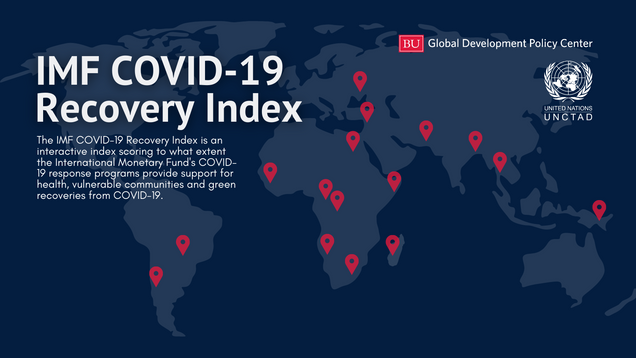全体准备? Ensuring Crisis Response Capacity at the IMF/World Bank Group Annual Meetings

By William Kring
As a surging US dollar wreaks havoc on emerging market and developing economies already battling high levels of indebtedness, climate change and inflation woes, central bank governors and finance ministers will convene in Washington, D.C. this week for the 2022 Annual Meetings of the International Monetary Fund (IMF) and World Bank Group. The meetings could not come at a more pivotal moment.
While experts have been warning for months that the world stands on the brink of a widespread sovereign debt crisis, coordinated political will is lacking. According to the United Nations Conference on Trade and Development (UNCTAD), nearly 60 percent of low-income countries and 30 percent of emerging market economies are in or near debt distress. Despite calls by 55 finance ministers for debt restructuring, no progress has been made on multilateral efforts to ensure debt levels are sustainable for emerging market and developing economies (EMDEs). UNCTAD warns that while there is still a window of opportunity to prevent a ‘policy-induced recession,’ if the current course of action is not corrected, the global economy could face a financial crisis worse than the 2007-2009 financial crisis.
The Annual Meetings represent possibly the last opportunity to prepare for the coming storm. There are three areas in which progress is urgently needed to avert a catastrophic global recession.
First, comprehensive debt restructuring is necessary across all creditor classes for EMDEs. In particular, the Vulnerable Group of Twenty (V20) Finance Ministers, comprised of 55 climate vulnerable economies, are facing high levels of indebtedness as well as an urgent need to mobilize the necessary resources to build resilient and low-carbon economies moving forward.
Second, while the resources available as part of the Global Financial Safety Net (GFSN) for crisis prevention and liquidity support via emergency financing institutions and arrangements has increased to more than $3.5 trillion over the last decade, recent research by the Boston University Global Development Policy (GDP) Center and Freie University Berlin finds that the GFSN has been scarcely utilized throughout the COVID-19 crisis. We find that coordination of the different components of the GFSN could optimize the utilization of the available resources and reduce transaction costs for both borrowers and lenders. However, the autonomy of each component of the GFSN to operate independently of influence from non-member countries or other organizations must be safeguarded.
Finally, the IMF needs to be better resourced to respond to the looming debt crisis. To ensure that the IMF is sufficiently resourced, it is essential that the 16th General Review of Quotas marshal sufficient resources to increase the lending firepower of the IMF, as there is an urgent need for quota reform. Additionally, developed economies could prioritize payments to the Poverty Reduction and Growth Trust and the new Resilience and Sustainability Trust Fund (RST).
At the GDP Center, the Global Economic Governance Initiative has developed a series of trackers to monitor the COVID-19 crisis response and recovery. Throughout the pandemic, these interactives have proved to be sources of vital public information for policymakers, reporters, researchers, civil society, students and others to explore and draw insights on the crisis and recovery process. These tools are updated quarterly, as research seeks to provide accountable and accessible information to monitor, track and aid the global economic recovery effort.
New updates to the trackers were launched in October 2022. See highlights from the latest releases below:
Global Financial Safety Net Tracker
![]() Th
Th
As of August 2022, the GDP Center and the Latin American Institute at Freie Universität Berlin estimate the financing available from the GFSN has again increased to approximately $3.7 trillion in lending capacity, or 4.5 percent of global gross domestic product (GDP). However, distribution and availability of these emergency funds has been highly uneven and unequal. According to researchers, there is an urgent need to coordinate the different elements of the GFSN to improve country access to vital fiscal resources. Explore the interactive and read the journal article.
IMF COVID-19 Recovery Index
 Since the April 2022 update to the IMF COVID-19 Recovery Index, the IMF has stopped tracking their financial assistance to countries as part of their response to the pandemic. However, the IMF still evaluates the impact of the pandemic on the countries, their authorities’ responses, and in certain cases, provides recommendations or conditionalities on policies that support public health, vulnerable populations and a “green” recovery.
Since the April 2022 update to the IMF COVID-19 Recovery Index, the IMF has stopped tracking their financial assistance to countries as part of their response to the pandemic. However, the IMF still evaluates the impact of the pandemic on the countries, their authorities’ responses, and in certain cases, provides recommendations or conditionalities on policies that support public health, vulnerable populations and a “green” recovery.
Between March 2020-September 2022, the IMF approved $174.21 billion for 152 programs in 93 countries, emphasizing support for public health, protecting vulnerable people and building a green recovery. The IMF COVID-19 Recovery Index assesses this global economic recovery process, calculating a composite score for each IMF country program or borrowing country, based on three equally weighted scores across the three pillars of public health, protecting vulnerable people and a green recovery.
While many IMF programs encouraged emergency measures for public health and the protection of vulnerable people, efforts in greening the recovery have so far been limited. For example, the Index shows that 100 of 142 IMF COVID-19 response programs analyzed do not address climate change, or green recovery efforts at all.
在
*
Never miss an update: Subscribe to the Global Economic Governance Newsletter